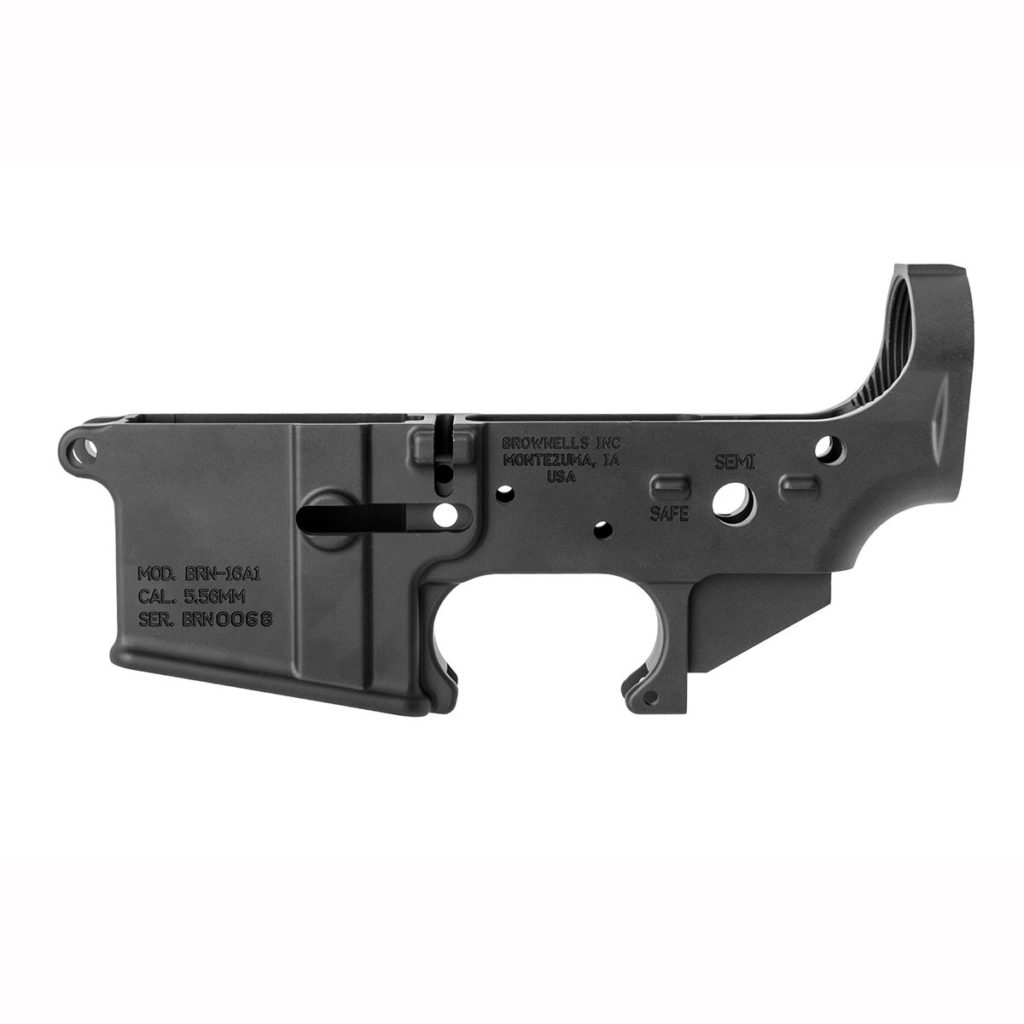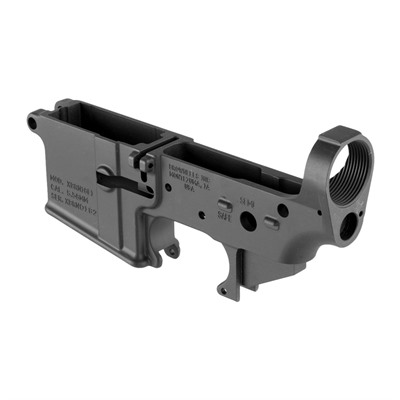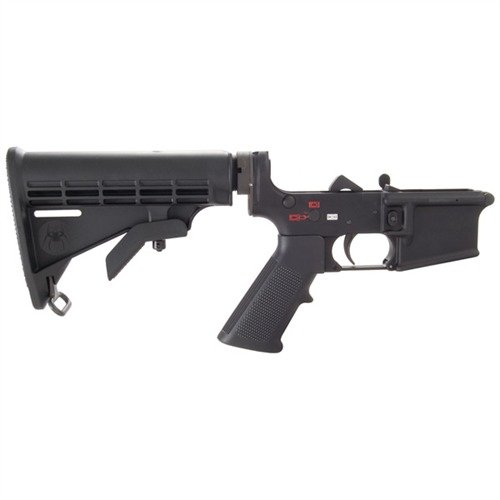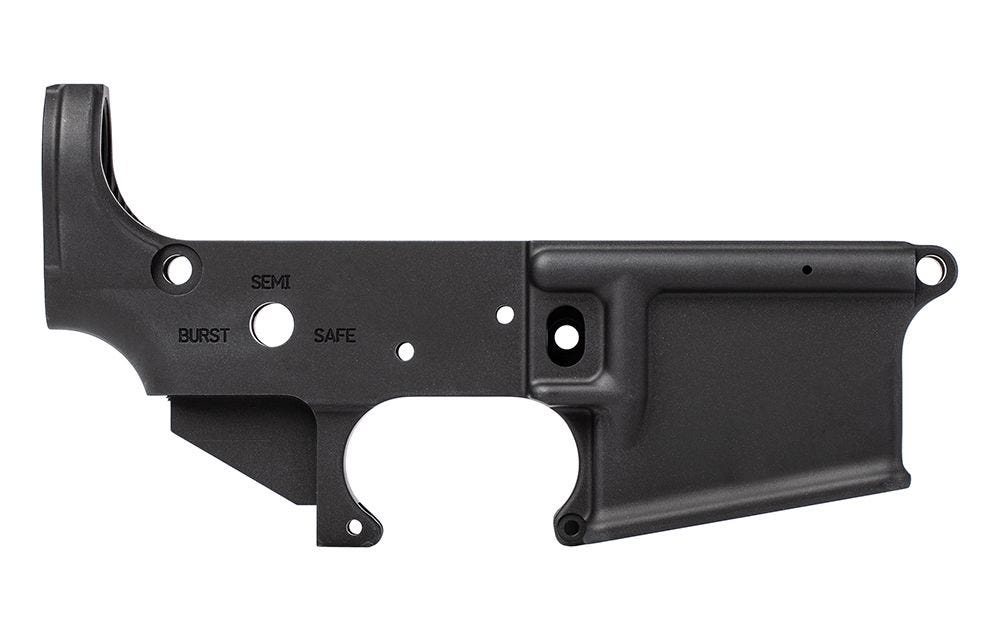The AR-15 rifle is one of the most popular rifles in the United States known for its accuracy and versatility. However, the AR-15 has undergone several modifications and iterations over half the century based on the M16A2/A3 and M4 service rifles.
Regardless of whether it’s your first time stepping into the AR platform or have been using one for a few years, you’re bound to have seen references of the AR-15 with the M4 and M16 military-issued rifles. These fully automatic rifles may look the same as the AR-15 but they do have their unique set of differences.
A Brief History of the AR-15 and M16 Models
The AR-15 rifle was first designed by Eugene Stoner back in 1956 when he was working with ArmaLite – an American arms company headquartered in California. The AR-15 rifle features select-fire, air-cooled, gas-operated magazine feeding to provide the soldiers with a lighter rifle for better maneuverability during the Vietnam war.
However, ArmaLite encountered financial difficulty and had to sell the AR-15 to Colt in 1959. This is when Colt decided to make some improvements to the initial AR-15 rifle design to boost the weapon’s accuracy and reliability. The redesigned AR-15 became the M16A1 rifle that was used in service during the Vietnam War in 1964.
AR-15 vs M16 Comparison
Similarities
Not only are both AR-15 and M16 rifles made with nearly identical materials and construction, but almost all their parts are directly interchangeable.
Upper Receiver Group
Both rifles have uppers that can share the following parts:
- Barrel
- Gas Block
- Gas Tube
- BCG
- Firing pin
- Upper
- Charging Handle
Both mil-spec AR and M16 use forged 7075-T6 upper receivers with 4150 (CMV) steel used for their barrels. Both also use similar stainlesssteel firing pins, gas tubes, front sight post/gas block combo, and bolt carrier group.
Lower Receiver Assembly
Both rifles have lowers that share the following parts:
- Buttstock
- Buffer Tube
- Castle Nut
- Bugger
- Recoil Spring
- Pistol Grip
Other than the upper receivers, materials used in both types of lower receivers are also almost identical with the same polymer buttstock, forged buffer tube, and forged 7075-T6 aluminum.
Differences
Despite almost identical upper and lower receivers, the AR-15 and M16 have several different components to set them apart from each other. Here are some of the differences:
Lower Parts Kit (LPK)
The first difference between the two rifles is the LPK. M16 uses a different trigger, disconnector, hammer, and safety selector lever in tandem with an auto sear to deliver a three-round-burst and fully automatic fire.
The AR-15, on the other hand, is not able to offer these two functions and can only work as a semiautomatic fire which is one round per trigger squeeze.
Hammer
The M16 hammer comes with an extra hook at the top that’s caught by the autosear while the AR-15 does not.
Trigger
The M16 trigger has a small notch cut into the far end to accommodate the M16’s disconnector.
Disconnector
The M16 disconnected has an extra tail behind its spring notch to work with the safety lever.
Safety Lever
The M16’s safety lever is made with extra channels and shoulders to keep the weapon safe for use in a semi, and full-auto function.
Auto Sear
The M16 auto sear has a little lever that rests above the safety lever, behind the hammer and trigger. This safety lever allows the M16 parts kit to provide all three modes of fire.
Bolt
The M16’s bolt carrier is fabricated differently from the AR-15’s commercial bolt carrier group with extra mass at the back of the carrier that will interact with the sear to reduce felt recoil during full-auto fire.
Lower Receiver
The AR-15’s lower receiver does not have enough space to accept the M16’s autosear. An M16’s lower receiver is milled or cut to make room for the sear.
Buying Guide for M16 Lower
Now that we’ve talked about a brief history of the M16 as well as its differences from the popular AR-15 rifle, here are a few aspects that you need to take into consideration when picking the best M16 lower receivers for your M16 building project.
Material
As with most firearm parts, it is critical for you to get one made of durable materials. It is doubly important for you to get a lower receiver that provides a good fit, ergonomics, and finish to ultimately boost your M16 rifle’s overall performance.
It is recommended to go for lower receivers made from 7075-T7 pure aluminum since they’re known to be one of the strongest and most durable materials for a rifle. However, if you’re shopping with a budget, you can opt for a 6061-T6 aluminum instead.
Finishing
In addition to the material used to machine the AR 15 lower receiver, you also need to look into its finishing.
Standard Type II anodizing process and hard-coat Type III anodized coatings are typically requested by united states military specifications but there are also other proprietary coatings available that offer even more benefits including better abrasion resistance and an even more durable finish that’s available in multiple colors to suit your preferences.
Billet or Forged Lowers
Lower receivers come in two types: billet or forged. Solid billet lowers milled in CNC machine will typically cost more than forged variants simply due to the extra time required for the machining process. Billet lower receivers also usually come with thicker walls for added strength and even an integrated trigger guard and a finer finish.
Forged lower receivers will result in a tougher receiver than cast lowers or billet lowers. However, the process of forging metal can result in slight surface imperfections such as minor indentations. Nonetheless, forged lowers are lighter than billet lower receivers and are more economic for the M16 rifle.
Lower Receiver Configuration (Complete, Stripped, 80%)
Lower receivers come in three variants: complete, stripped, and 80%. Obviously, as the name suggests, fully completed lower receivers come with all the lower parts kit and buffer assembly installed helping you save time and effort to build a rifle.
Having a completely assembled receiver also means you get to avoid making any costly mistakes, especially with such a critical part of the rifle.
Stripped lower receivers offer an excellent price-performance ratio with a ton of different styles, added ergonomic features, and ambidextrous compatibility. A stripped lower receiver lets you customize and add your favorite parts to your rifle.
Lastly are 80% lower receivers that require a lot of technical skills to complete it. You’ll need necessary drilling and machining tools just to assemble a 100% upper and this process may not be the best for beginners.
Best M16 Lower Receivers For Sale in 2022
If you’re looking for the best M16 lower receiver but aren’t sure where to begin, then you’ve come to the right place. Our review article today will talk about some of the top M16 lower receivers available on the market that you can get your hands on now. Without further ado, let’s dive straight into our top picks of the best m16 lower receivers.
Brownells BRN16A1 AR-15/M16 A1
As mentioned in the section above, the original AR-15 rifle has encountered multiple iterations and improvements over the years and has come up with different types of AR-15’s such as the A1, A2, A3, and A4. However, these variants are actually related to the different generations of M16 guns instead of the AR-15.
The M16 rifle has noticed an increased interest among the community as well as firearm collectors in recent years. Those looking to start a new project of building their own M16 rifle may want to consider the Brownells M16 A1 lower receiver that sports a retro style.
The lower receivers can be easily recognized thanks to its “Full Magazine Fence” design to indicate that it belongs to the third iteration of the A1 lower series.
In addition to that, the Brownells stripped lower receivers are made from 7075 T6 aluminum forging by NoDak Spud (NDS) milling shop. Brownells then later machined them to mil-spec dimensions and finished it off with a matte grey or black hard anodized finish to suit the aesthetic of modern upper receivers.
The Brownells A1 retro lower receiver is clone correct but there have been reports of the lower receiver not offering a snug fit to other manufacturers’ upper receivers. This might mean that you will be limited to only getting upper receivers by Brownells.
There are also a few comments on how the anodizing isn’t as perfect as you might expect since there may be traces of discolored residue from the anodizing process.
Nevertheless, those are relatively minor setbacks when compared to the fact that NoDak Spud products are of high quality and they create some of the best AR 15 lower receivers on the market that match the features of the original M16A1 receiver.
In fact, the BRN-16A1 stripped lower receiver precisely mirrors the original form and dimensions of the proper m16A2 front take-down lug profile while still being able to accept all standard AR-15 components of an upper receiver.
Overall, the Brownells BRN16A1 lower receiver is a solid alternative for those who want to build a retro or mil-spec accurate reproduction of the original M16 A1 gun without any wobbling issues.
Pros
- Mil spec stripped lower receiver that offers an accurate reproduction of an A1 receiver.
- Made from forged 7075 T6 aluminum and is available in black or grey finish.
- Made by NoDak Spud (NDS) in the USA for top notch quality.
- Comes with simple, engraved markings.
Cons
- May have an imperfect anodized finish due to anodizing process.
- Might not offer a tight fit with some upper receivers.
Brownells AR-15 Blemished XM16E1
Ever since the popularity of “retro AR guns” has exploded in the past couple of years, many AR 15 lower receiver manufacturing companies, dealers, and merchants have found a niche in the market. This is what drove Brownells in conjunction with NoDak Spud (NDS to bring back the M16A1 upper/lower receivers).
NDS forges the AR 15 stripped lowers from aluminum and Brownell’s machines and corrects them to be the exact replica of early U.S. Army XM16E1 guns or the later released famous “XM177” Commando Carbine models.
The “Partial Fence” type of receiver has the captive pivot pins held in place by a detent housed on the added reinforcement rib. The reinforcement is placed above the magazine release, right below the ejection port cover.
Brownells initially faced some comments from the AR community about the finishing being too black and they preferred the original Colt XM grey finish. This is what led the company to provide AR 15 stripped lowers in both grey and black hard coat anodized finish to match the original XM16E1.
While the lower receivers may have been rejected by quality control due to anodizing issues, these products still meet all the requirements in terms of quality and specifications. The Brownells blemished lower receiver comes with the same quality forging and machining as the QC-approved receivers.
All in all, this is a top choice if you want to refinish your M16 rifle to period-correct contours without busting your budget. The Brownells AR 15 M16A1 blemished lower even comes with a matte grey or matte black hard anodized finish to make a perfect match for your gun’s aesthetics.
Pros
- Made from 7075 T6 aluminum with a black or grey finish.
- NoDak Spud forging process conducted in the USA.
- Completely stripped lower.
- Solid lower that matches the original XM16E1 rifle at a reasonable price.
- Reinforcement above the magazine release and below the ejection port cover.
Cons
- Colors may vary greatly depending on stripped lower receivers.
- Products may also come with scratches and dents.
Brownells AR-15 Blemished M16 A1
Next on our list is yet another AR 15 lower receiver by the same manufacturer as the top two on our list today. In addition to their Retro Rifle series which includes six ”black rifles” BRN16 models, the lower receiver manufacturing company has also released new “retro” components suited for the M16A1 model.
The M16A1 lower receiver is built from 7075 T6 forged aluminum at NoDak mill shop before being precision machined to final dimensions by Brownells themselves. Thanks to its retro aesthetic, the M16 forged lower receiver makes an ideal solution for those who want to reproduce the Vietnam-era rifle with the correct A2 profiles.
Furthermore, the blemished lowers are often cheaper than regular ones simply due to the small aesthetic imperfections caused by discoloration and anodizing flaws. Just like the one before, despite the aesthetic flaws, these AR 15 lowers offer the same quality as QC-approved receivers.
However, there have been a few reports of wiggling when pairing the AR lower receiver with an upper from a different company.
Other than that, some may also comment that the “fire & safe” markings on both sides of the receivers are not historically accurate for the “A1” retro lower. However, that’s a pretty minor drawback considering the fact that Brownells is selling these at a bargain price.
Pros
- Made from 7075 T6 aluminum forging.
- NoDak Spud forging and made in the USA.
- Completely stripped reproduction of an A1 receiver.
- Affordable AR 15 lower that’s machined by Brownell’s to the same spec as the company’s Full Price options.
Cons
- Some wiggling when pairing the M16 lower with uppers from a different brand.
- Colors may vary greatly depending on upper receivers.
- Products may also come with scratches and dents.
Spikes Tactical AR-15 Complete
Fourth on our list is a lower receiver made by a renowned manufacturer of complete firearms that has also added striped and assembled AR-15 receivers to their list of products.
One of the best things about the Spikes Tactical M4 lower is that it allows a gun owner to convert a regular civilian semi-automatic version of the AR-15/M16 to a selective-fire gun with a drop in auto sear.
This is possible because Spikes has decided to create lowers with a milled shelf to allow the installation of a Registered Drop In Auto Sear (RDIAS).
The complete Spikes forged AR-15 receiver comes with Standard Spikes Lower Parts Kit (LPK) and fire control group factory installed. If you’re worried about being stuck with bad stock triggers, you can rest assured that the company provides a better-than-average trigger that feels great to shoot.
Other than that, the Spikes Tactical lower comes with the company’s proprietary Pro Pistol grip with an M4 style six-position stock above a mil-spec buffer tube that’s 1.146 inches in diameter and also a Spikes ST-T2 tungsten heavy buffer.
The M4-style lower sports an adjustable buttstock with a standard black pistol grip that’s molded from reinforced polymer that’s durable and lightweight to not weigh you down.
Since the Complete AR-15 lower is designed to mil-spec dimensions, you’ll find very little rattling or wobbling when assembled with an upper to create a complete rifle. However, the standard M4 carbine collapsible stock is quite basic and can be quite loose when used with a mil-spec buffer tube.
In terms of construction, the AR 15 lower is made from 7075-T6 aluminum forging and hard coat anodized in a matte black finish for better durability and corrosion resistance. All in all, the Spikes Tactical lower is a great choice for those who want to convert their rifle into a full-auto weapon with selector markings.
Pros
- Comes with Spike’s tactical trigger, Spikes tactical pro pistol grip, and 6-position M4 stock.
- Machined from forged 7075 T6 aluminum with mil-a-8625F Type III Class 2 Hard Coat Anodized Finish for corrosion resistance.
- Three positions color-coded bullet selector.
- RDIAS compatible thanks to the low shelf.
- Mil-spec buffer tube with ST-T2 Tungsten Heavy Buffer.
Cons
- One of the more pricier AR 15 lower receivers available.
- Standard M4 carbine collapsible stock is loose when paired with a buffertube.
Aero Precision Special Edition M16A4 Stripped
No best lower list is ever complete without a model from Aero Precision. Aero Precision is a popular mil-spec parts and accessories manufacturer that also excels in fabricating AR-15 lower and upper receivers. Aero Precision lower receiver is a no-frills workhorse that offers a middle ground in terms of quality and price.
The AR 15 lower is machined from forged 7075 T6 aluminum according to mil-spec dimensions to ensure a perfect fit with Aero stripped upper receiver as well as other AR-15 standard components available on the market.
The model also does not have any logos or markings on the right side but has markings on the left that faithfully replicate the actual M16A4 rifles.
Another highlight about the Aero Precision lower is that it features 5.56mm caliber markings and the inclusion of “Safe/Semi/Burst” selector markings. While the selector has a “Burst” option, you can’t actually modify the AR 15 lower for full auto mode.
So that option is just for aesthetic purposes. Speaking about aesthetics, the stripped lower is engraved with a distinctive Aero insignia that doesn’t affect the authenticity of the rifle.
Overall, the Aero Precision Special Edition M16A4 stripped lower is a very good alternative for those who are looking to build a clone or an extremely close replica of the M16A4 used by the United States Military.
Pros
- Made in the USA for quality guarantee.
- Machined from high strength 7075 T6 forged aluminum with hardcoat anodized black finish.
- Safe, Semi, Auto Selector markings.
- AR 15 stripped lower offers an excellent base for an M16A4 clone.
- Features “Property of USA” and “Cal. 5.56mm” markings.
- Mil-spec dimensions to fit an aero stripped upper receiver.
Cons
- May be a little expensive.
- May face light roll marks.
Types of M16 Lower
Those who have successfully completed their rifle recommend assembling or getting a complete upper before concentrating on the lower. This is because the AR 15 lower is much more straightforward compared to the upper assembly.
Nonetheless, there are plenty of M16 lower assemblies and lower receiver parts kits available on the market that can get pretty confusing. To help you out, we will be talking about the few types, materials, and configurations available for you to better identify which type is suitable for you.
Material
Though AR-15/M16 lowers come in steel and titanium iterations, the more common materials used to construct them are aluminum and polymer. But there are two types of aluminum alloys used in making forged receivers and they are the 6061 T6 and 7075 T6.
The 6061 aluminum was the first material used in Eugene Stoner’s M16 but the forged receivers started to corrode in the tropical environment of Vietnam due to higher moisture levels. This is what drove the manufacturers to switch to 7075 T6 aluminum since they’re stronger than the 6061.
While the 7075 is stronger than the 6061, its hardness also means that machining it is much more difficult and the process will cost twice as much as the 6061 solid block. Still, those with a little bit more budget looking for AR 15 lowers with better mechanical properties can opt for 7075 T6 aluminum alloys.
Aside from metal, polymer receivers have also started gaining popularity over the last few years since advanced technology has allowed the new generation of polymer to be relatively stronger, lightweight, and more economical to produce.
The new generation of polymer uses injection molding technology that combines high-strength reins with metal inserts at critical areas of lowers to ensure good durability.
Casting Process
Other than the material used, the lower can be categorized based on their casting process. There are currently three different types of manufacturing methods: cast receivers, billet receivers, and forged manufacturing methods.
Cast receivers have a loose crystalline structure making them the weakest choice that is also least aesthetically pleasing to the guy. Cast lowers are not generally recommended since they do not possess the strength or durability to withstand the day-to-day abuse introduced by the AR-15 weapons.
Billet aluminum lowers are machined and milled from a solid block of pure aluminum on CNC machines. However, the process can be quite time-consuming, making billet aluminum lowers much more expensive than a forged one.
Billet lowers usually come with thicker walls for added strength and even an integrated trigger guard and a finer finish. On the flipside, billet receivers are rugged and nice-looking variants that are inherently weaker than the forged models.
Lower receivers are more commonly made through the forging process since it produces the strongest aluminum form. AR 15 lowers manufactured via the forging process are strong enough to handle the abuse of a heavy-duty weapon such as the M16.
Styles
If you’ve done your research, you’d have noticed that the aftermarket M16 lowers come in many styles like assembled, stripped, or 80% receivers.
Complete lowers come with all the critical parts included and assembled. Stripped lowers are just a formed piece of aluminum that allows gun owners to build their own lower according to their own preferences and favorite parts.
The freedom of full customization helps AR enthusiasts save money as well. Both the complete and stripped receivers are considered a firearm themselves and will require a NICS check or an FFL in order to purchase.
80% lowers on the other hand are partly finished products as suggested by the 80% label. 80% of receivers don’t even have holes and milling.
While this type of receiver does not require a NICS check or FFL to build the weapon, you may need to be prepared to get additional tools such as a drill press or lathe along with the necessary technical skills required to assemble a 100% receiver.
Conclusion: Can AR 15 Lowers be used on M16?
With the advancement of technology and the rising popularity of AR-15 firearms, there are simply more parts available for an AR-15 in general than there ever was before. While this means that you have a wide range of different options to pick from, it can also make it even more complicated to choose the best one for your overall assembly.
If you’re still confused about which to pick, you can just get one from any one of the models we’ve covered above knowing you’ll get a perfect match for your firearm.
Regardless of which model you’ve decided to invest your money in, you should always refer to our buying guide and online reviews when searching for a new receiver. We hope our article today on the top M16 A1 upper products has given you enough insight and information to make an informed purchase.
Frequently Asked Questions
Can I legally build an M16 from an AR 15?
Yes, you can legally build an M16 from an AR 15 as long as you’re a Class 3 FFL. Without the FFL, you’re not allowed to build a machine gun, and that includes using 80% receivers.
Can I install any M16 parts in my AR 15?
No, M16 parts cannot fit AR 15 due to differently shaped parts that prohibit the kit from being installed in a commercial lower.
Is it illegal to own any M16 parts?
No, it is not illegal to own M16 parts and you can even use some of them on your AR-15. The parts include a BCH, buttstock, and buffer. But you cannot own an autosear with your weapon as owning these parts together is illegal under “constructive intent”.
Can I buy a full-auto M16?
Yes, you can buy a full auto M16. But take note that they’re expensive. The going price for an early Colt M16 transferable machine gun is around $25,000 and that value can go up in the event of a low supply.

Hello there, it’s Michael here. A gun lover since young, served the country for the last 20 years. I started the blog to share my experience and gun-related knowledge accumulated throughout the years. Hopefully, you will find something useful over here or just have fun! You can learn more about me here.






